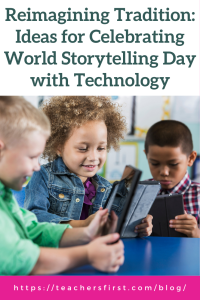“When we reject the single story, when we realize there is never a single story about any place, we regain a kind of paradise.”
Chimamanda Ngozi Adichie
Storytelling has been an essential part of human communication for thousands of years. We have all probably experienced hearing stories that have been passed down from generation to generation. Storytelling is a powerful means for people to connect and empathize with one another and fully express themselves.
World Storytelling Day is an annual event on March 20th and is an opportunity to celebrate the rich history of storytelling. While the art of storytelling has traditionally been thought of as an analog tradition, technology can be used to elevate the way we tell stories. In this blog post, I’ll share some ideas for how you can integrate technology into your celebration of World Storytelling Day.
- Community Storytelling Project – One way to celebrate World Storytelling Day is to hear the stories of those in your classroom community. You can invite guardians and other classroom community members outside the classroom to share their personal stories virtually. For example, you can set up a Flip (reviewed here) that can be shared with your classroom community members and include a prompt they can respond to. I’d suggest launching this a week or two before you plan to celebrate World Storytelling Day to give community members time to contribute. If you have some community members that would not be able to access Flip or whatever tool you choose to gather their stories, consider designating some “office hours” for them to come in and record their stories. Once you’ve gathered these stories, let students go into Flip to listen to the stories of their peers’ families and friends and reflect on what they learn.
- Creating Metaphors – This protocol, adapted from The Courage to Teach by Parker Palmer, is a simple way to incorporate storytelling through figurative language. Initially designed for adults, it can easily be adapted to use with your students. The point of this exercise is to allow students to be as silly or creative as possible and tap into their imagination. It can be used as a community-building activity or to synthesize their learning. Students respond to this sentence stem, “When I am at my best as a student, I am ____.” You can create a Padlet (reviewed here) where students can post their metaphors and comment on each other’s creations (example).
- Life Map – A Life Map is a visual timeline. They are generally used to describe your life over a period of time. You can use this life map activity as a prewriting exercise for student autobiographies or as a standalone activity. A Jamboard (reviewed here) would be a great tool to create a simple life map using digital post-its and images that students can share.
- Augmented Reality Storytelling – With AR tools like Metaverse (reviewed here), students can create stories that come to life uniquely and interactively. This article lists some creative examples of how students can create AR stories in their classroom, like creating an AR scavenger hunt where users must find and scan objects in the real world to reveal parts of the story!
- Collaborative Storytelling Projects – This can be done through tools like Google Docs or Google Slides (reviewed here), where students can collaboratively write and share parts of their stories. Once the story is complete, it can be shared on World Storytelling Day. Consider hosting an official event inviting other classes to come in and listen.
However you decide to celebrate World Storytelling Day, I hope you provide a space for students to share their personal stories and those they care about.
Do you have a favorite storytelling lesson or tool? We would love to hear how you elevate storytelling in your classroom in the comments below!


